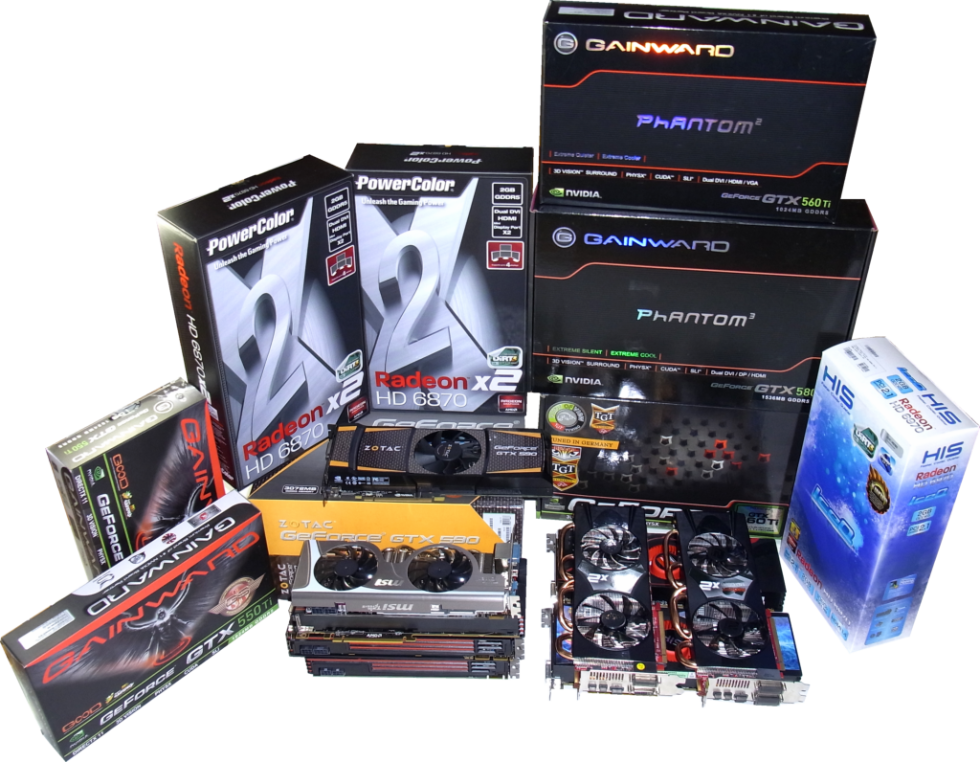Drivers or displaced?
Installing the drivers for a really optimal result is only something for hardcore and graduated cold-showers. What still works with single cards quickly turns into a game of patience and luck. Let’s break it down a bit. For example, it is very difficult to persuade two non-reference Nvidia cards to SLI at all as solutions of two different board partners. Out of 6 different GTX 580s, only two could be used together, out of 5 GTX 570s, at least 3.
AMD is two steps ahead in terms of compatibility here, only the installed chip plays a role. This head start goes down the drain when you try to coax two dual-GPU cards to Quad-CrossfireX. This takes forever and was also acknowledged several times with a blue. The Crossfire profiles are not externally accessible and also not freely configurable and assignable. This advantage remains with Nvidia alone. Thus, those who get involved in multi-GPU operation should bring time and nerves with them.
CrossfireX with 2 cards
Sure, the measurable average frame rates are in a good relation to the price, but you might not really want to watch many games. If jerks are still so noticeable even in the range of well over 50 fps that you almost believe in reloading jerks, then you have to shift the relations. One question can be confidently answered in the negative: it’s not really worth buying an inexpensive card now and upgrading to another one later if needed. The frames per second gained are almost constantly interspersed with micro-stutters, so that a real gaming enjoyment on the highest level is not given. The cards below the Radeon HD 6950 are hardly suitable for a CrossfireX with only 2 cards. Even though the values are nice to look at, it jerks more and more violently with decreasing GPU performance.
To be fair, not everyone reacts subjectively the same way to time-shifted frame sequences, and some cheap TFTs also unconsciously help to “smear” the frames. Despite everything, AMD still has a huge mountain of work ahead of them if they really want to score in the dual-GPU sector.
Triple and Quad CrossfireX
The performance of the two versions we tested (in one we had simply crippled a GPU of the HD 6870 X2, in the other we had combined the X2 with a single card) not only surprised us, but even almost completely convinced us. If multi-GPU, then please do so! The third GPU is almost always used to eliminate micro-stutters and not to increase the absolute frame rates. The fourth GPU is cosmetic and hardly usable.
If AMD would equip the HD 6870 with 2 Crossfire connectors and add some RAM – a triple of 3 x HD 6870 would probably be the absolute price-performance winner with a minimum of stutters. At the moment, however, you can only go this way via the detour of the Powercolor HD 6870 X2 and a single HD 6870. The 480 Euros required for this are still much less than a GTX 590 costs, which nominally loses the performance comparison and also lags slightly behind in the jerks.
We would like to see AMD put more emphasis on balancing the dual-GPU solutions. AFR and all its disadvantages aside, there is still room for improvement. The triple shows the way.
SLI
Nvidia shows how it could work, but it is still far from the land of dreams. Still, at least the SLI combinations of the stronger cards are really fun in places, even if the sporadically occurring stutters always bring us back down to earth. Cards like the GTX 550 Ti are haphazard for an SLI. Nice frame rates in the charts, nasty micro jerks in reality. You could also throw the money out of the window.
Concluding remarks
If we are to be honest, still nothing revolutionary has happened, even though Nvidia’s balancing has been improved a lot. Currently, neither of the two solutions can really meet the demand for a 100% smooth and properly rounded display, especially since the manufacturers almost always price the cards in such a way that a nominally equally strong multi-GPU team costs just as much in total as a comparable single card. We would then prefer these in any case. The triple solution of three mid-range devices would be THE hit par excellence, if not for… First, the Powercolor HD 6870 X2 is hardly available (yet), second, it is unfortunately not really quiet, and third, you need a lot of courage and optimism if you want to rely on the Crossfire profiles.
We also learned one thing: the stronger the paired cards are, the less you feel the side effects, which unfortunately completely rules out the sensation of two superior cheap cards at the moment. Crossfire and SLI are really only worthwhile from the mid-range upwards, whereby SLI currently has the lead. Thus, they are rather uninteresting for upgraders and price foxes. Closing words? Then rather a single card.
- 1 - Einführung und Übersicht
- 2 - Wir funktionieren Crossfire und SLI?
- 3 - Mikroruckler - so klein und doch so ärgerlich
- 4 - Stufe 1: CrossfireX mit 2 GPUs
- 5 - Stufe 1: CrossfireX mit 2 GPUs versus SLI
- 6 - Stufe 2: CrossfireX mit 3 GPUs
- 7 - Stufe 3: CrossfireX mit 4 GPUs versus SLI
- 8 - Testsystem und Benchmarkauswahl
- 9 - Benchmarks: 3DMark11 und Sanctuary
- 10 - Benchmarks: DirectX 11 Spiele
- 11 - Benchmarks: DirectX 10 Spiele
- 12 - Benchmarks: DirectX 9 Spiele
- 13 - Leistungsindex und Leistungsaufnahme
- 14 - Zusammenfassung und Fazit
































9 Antworten
Kommentar
Lade neue Kommentare
Mitglied
Urgestein
Veteran
Urgestein
Urgestein
Mitglied
Veteran
Urgestein
Urgestein
Alle Kommentare lesen unter igor´sLAB Community →